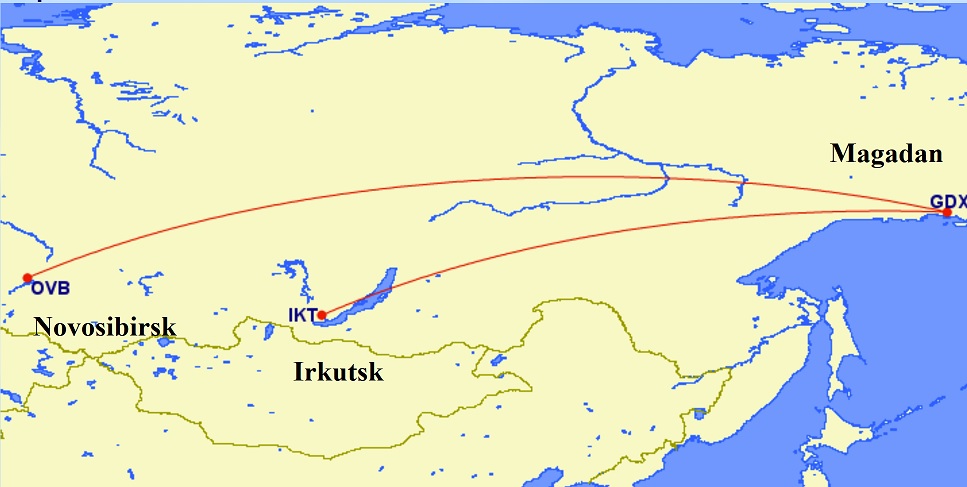oneworld airline S7 Siberian Airlines flight 5220 from Magadan to Novosibirsk declared a mayday while climbing out on departure ” due to unreliable airspeed and related problems with autopilot and autothrust.”
The Airbus A321 had 192 passengers and 7 crew on board and tried to return to Magadan twice but severe icing prevented them from doing so. They flew four and a half hours to divert to Irkutsk.

[F]ollowing takeoff the aircraft flew into clouds and into a zone of severe turbulence accompanied by strong icing. As result the aircraft got into a difficult spatial position…
On Dec 8th 2021 Rosaviatsia released a first safety information stating the aircraft had been de-iced prior to departure in heavy snow, temperature -9 degrees C…After takeoff all three air data systems malfunctioned resulting in unreliable airspeed (different airspeeds on each system), the flight controls went into minimum operation mode (editorial note: unclear whether this means direct law).
The plane landed in Irkutsk without issue. “Frozen fluids” were found in the nose of the aircraft causing issues with the plane’s sensors. There was also ice on the wings. It had,
been de-iced in two stages, first with fluid type I and second with fluid type IV. However, only wings and stabilizer surfaces were de-iced. The fuselage, which had accumulated a large amount of snow in the heavy snowfall during 2.5 hours on the ground, had not been de-iced.
After the windshield heating had been turned on, the snow melted and water flowed down the front part of the fuselage. Continuous snow fall and melting during taxi in ambient temperatures below freezing caused a layer of frozen ice at the front part of the fuselage disrupting the airflow of the pitot tubes. Therefore, takeoff with the fuselage surface and engine hoods covered with a thick layer of snow in icing and turbulence conditions posed a real danger to the flight safety.
There are reports of counterfeit de-icing fluid as well. There are unconfirmed reports that deicing was done with automotive liquids.
Whenever I hear about a de-icing issue – perhaps it’s all of my years living in the D.C. area – my mind immediately goes to Air Florida. On January 13, 1982, Air Florida flight 90 from Washington’s National airport to Fort Lauderdale was improperly de-iced, too much time elapsed between de-icing and takeoff, and the pilots of the Boeing 737-200 pulled up behind a DC-9 hoping that plane’s exhaust would melt snow and ice on its wings.
The plane failed to gain sufficient thrust during takeoff, gained a maximum altitude of just about 350 feet, and crashed into the 14th Street Bridge. Most passengers and crew perished with the breakup of the plane’s fuselage and freezing temperatures in the Potomac River, and people in cars on the packed bridge died as well. The day after the incident Howard Stern, then a local DC radio personality, called Air Florida from his show to ask for the price of a one way ticket from National Airport to the 14th Street Bridge.
Early in the year there was a Frontier Airlines de-icing near-disaster averted by a flight attendant who noticed a significant amount of snow and ice on the wings after the de-icing contractor had reported the job as complete.
The pilots of the S7 Siberian flight are heroes for managing to control the aircraft under these circumstances.


They might be heroes, but one must wonder why they chose to continue flying for hours after experiencing the IFE when suitable airfields likely existed between Magadan and Irkutsk.
I’m with Ari – Khabarovsk, Vladivostok, Yakutsk, and Petropavlovsk are all much nearer to Magadan and would have easily accommodated an A321. For the sake of comparison for readers who may not be familiar with Russian geography, this plane flew a distance roughly equal to NYC and Salt Lake City.
Wow!
Why the mention of Howard in this article?
I remember one man very well, Lenny Skutnik, who jumped into the freezing waters of the Potomac
to rescue a woman. I will always revere him as a true hero.
A 321 with 192 passengers?
Isn’t that kind of tight?
Although the Air Florida 737 did have some snow on the wings, the root cause of the accident was the failure of the pilots to turn on the anti-ice heat on the engine probes that measure pressure to set power on takeoff. So while they thought they had the correct takeoff power, they actually only had about 2/3rd of the correct thrust setting.
The FO sensed the sluggish acceleration and questioned the Captain to no avail. And even while struggling to remain airborne, neither pilot advanced the throttles any further.
Sadly Howard is a shadow of his former self but the “call” was fake. And hardly relevant to the story.
The comment that brought Howard Stern his most notoriety during his time on Washington, DC radio in the early ‘80s was the infamous Fourteenth Street Bridge Incident. As morning man at “DC101” WWDC, Stern was reacting to the Air Florida flight that crashed into the bridge in February 1982. “What’s the price of a one-way ticket from National to the Fourteenth Street Bridge?” he asked. “Is that going to be a regular stop?”
While it was a make believe call – Stern never actually phoned the airline – the riff became legendary.
http://www.insideradio.com/free/stern-on-stern-i-had-a-lot-of-rage-and-i-was-going-to-let/article_13263a96-656a-11e8-93d6-8f4a0c7ff8b0.html